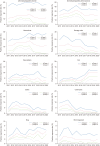Allergic Sensitization Pattern in the Korean Dermatologic Patients
- PMID: 36478425
- PMCID: PMC9763908
- DOI: 10.5021/ad.21.260
Allergic Sensitization Pattern in the Korean Dermatologic Patients
Abstract
Background: Avoiding causative allergens is important for controlling the clinical course of allergic diseases. Allergen sensitization is influenced by many factors including the environment and lifestyle. The socioeconomic development, climate, and lifestyle changes have increased the prevalence of allergic diseases worldwide. However, there is little information about changes in the trend of the common allergens over time.
Objective: This study was aimed at identifying the trends of the common allergens in Korea over a 10-year period based on the results of the multiple allergosorbent test chemiluminescent assay (MAST-CLA).
Methods: We retrospectively reviewed the medical records of 5,760 patients aged ≥18 years who visited the Dermatology Department at a tertiary hospital over a period of 10 years. The serum total immunoglobulin (Ig) E and specific IgE levels to 41 allergens were determined using MAST-CLA, along with the clinical diagnosis, duration of illness, white blood cell count and eosinophil percentage.
Results: Dermatophagoides farinae, Dermatophagoides pteronyssinus, and house dust were the most prevalent allergens during the 10 years period, but the percentage of higher class responses has decreased in recent years. The number of patients sensitized to house dust (p<0.001), dogs (p=0.005), and cats (p<0.001) increased while that of patients sensitized to cockroaches (p<0.001) and storage mites (p<0.001) decreased over time. There were no significant changes in the total number of sensitizing allergens over time.
Conclusion: The common allergens have changed over time. Based on the findings of this study, physicians and patients should consider changing their strategies for disease prevention and management.
Keywords: Allergens; Allergy; Atopic dermatitis; Immunoglobulin E; Multiple allergosorbent test chemiluminescent assay; Time trend.
Copyright © The Korean Dermatological Association and The Korean Society for Investigative Dermatology.
Conflict of interest statement
The authors have nothing to disclose.
Figures
Similar articles
-
House dust mite and cockroach exposure are strong risk factors for positive allergy skin test responses in the Childhood Asthma Management Program.J Allergy Clin Immunol. 2001 Jan;107(1):48-54. doi: 10.1067/mai.2001.111146. J Allergy Clin Immunol. 2001. PMID: 11149990
-
The Differences in Serum Quantitative Specific IgE Levels Induced by Dermatophagoides pteronyssinus, Dermatophagoides farinae and Blomia tropicalis Sensitization in Intermittent and Persistent Allergic Asthma.Acta Med Indones. 2017 Oct;49(4):299-306. Acta Med Indones. 2017. PMID: 29348379
-
Comparing the results of intradermal skin tests for four dust mite allergens in dogs with atopic dermatitis in Thailand.Vet World. 2020 Nov;13(11):2381-2387. doi: 10.14202/vetworld.2020.2381-2387. Epub 2020 Nov 9. Vet World. 2020. PMID: 33363330 Free PMC article.
-
The effect of immunotherapy on cross-reactivity between house dust mite and other allergens in house dust mite -sensitized patients with allergic rhinitis.Expert Rev Clin Immunol. 2021 Sep;17(9):969-975. doi: 10.1080/1744666X.2021.1968834. Epub 2021 Aug 18. Expert Rev Clin Immunol. 2021. PMID: 34388949 Review.
-
House dust and forage mite allergens and their role in human and canine atopic dermatitis.Vet Dermatol. 2006 Aug;17(4):223-35. doi: 10.1111/j.1365-3164.2006.00532.x. Vet Dermatol. 2006. PMID: 16827665 Review.
Cited by
-
National prevalence of atopic dermatitis in Korean adolescents from 2009 to 2022.Sci Rep. 2024 May 29;14(1):12391. doi: 10.1038/s41598-024-62475-4. Sci Rep. 2024. PMID: 38811655 Free PMC article.
References
-
- Odhiambo JA, Williams HC, Clayton TO, Robertson CF, Asher MI. Global variations in prevalence of eczema symptoms in children from ISAAC Phase Three. J Allergy Clin Immunol. 2009;124:1251–1258.e23. - PubMed
-
- Kim BK, Kim JY, Kang MK, Yang MS, Park HW, Min KU, et al. Allergies are still on the rise? A 6-year nationwide population-based study in Korea. Allergol Int. 2016;65:186–191. - PubMed
-
- Park DS, Cho JH, Lee KE, Ko S, Kim HR, Choi SI, et al. Detection rate of allergen-specific IgE by multiple antigen simultaneous test-immunoblot assay. Korean J Lab Med. 2004;24:131–138.
-
- Jang WR, Nahm CH, Kim JH, Lim DH, Jang TY, Moon YS, et al. Allergen specific IgE measurement with Polycheck Allergy: comparison of three multiple allergen simultaneous tests. Korean J Lab Med. 2009;29:465–472. - PubMed
LinkOut - more resources
Full Text Sources
Miscellaneous



